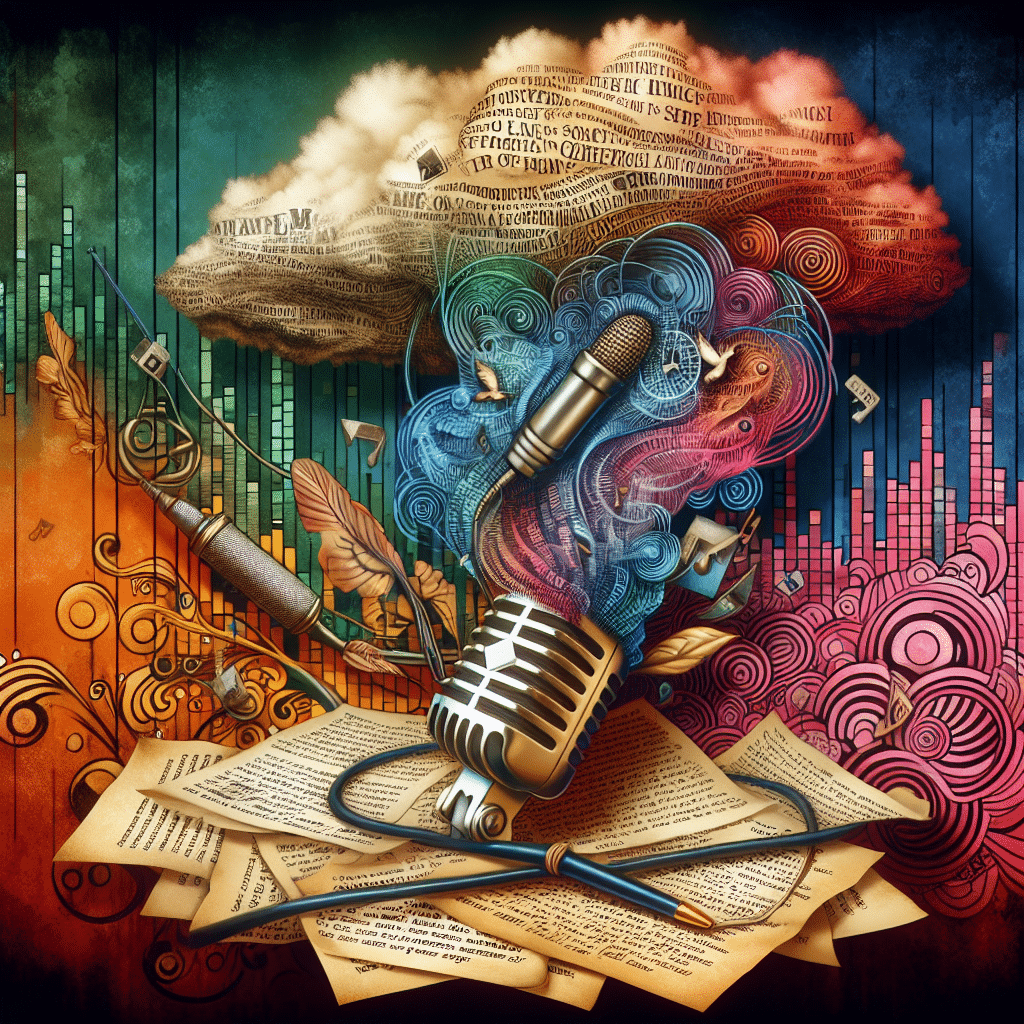The Art of Metaphor: How Hip Hop Lyrics Use Language to Create Imagery

Hip hop is often celebrated for its rhythmic beats and captivating flows, but its true artistry lies beneath the surface—within the metaphors that drip from the lips of its lyricists. Metaphors in hip hop elevate the music from mere sound to a profound exploration of life experiences, societal issues, and personal struggles. This article delves into the intricate use of metaphor in hip hop lyrics, highlighting its power to create vivid imagery and convey deep meanings.
Understanding Metaphor in Literature
Before diving into hip hop specifically, it is vital to understand what metaphors are. A metaphor is a figure of speech that makes a direct comparison between two unrelated subjects, suggesting that they are alike in some way. For example, saying "time is a thief" implies that time possesses the ability to steal moments away from us, imbuing the passage of time with a sinister quality. Metaphors are crucial in literature as they evoke imagery, enrich texts, and engage readers more deeply.
In hip hop, metaphors serve similar purposes. They embellish lyrics, facilitating emotional connection and drawing listeners into vivid imagery that resonates with their own experiences.
The Role of Metaphor in Hip Hop Lyrics
See Also: Collision of Styles: Diverse Voices in This Month’s New Rap Releases
Collision of Styles: Diverse Voices in This Month’s New Rap ReleasesEmotion and Personal Experience
A hallmark of hip hop is its narration of personal stories and emotions. Artists often use metaphor to express feelings that may be difficult to articulate explicitly. For instance, in Kendrick Lamar’s "The Art of Peer Pressure," he likens peer influence to a "puppet master," conveying the complexities of social dynamics. In doing so, Kendrick captures the struggles of adolescence and the pervasive impact of friendships without directly stating the obvious.
Through metaphors, hip hop artists can encapsulate profound emotions within a few succinct lines. This compression of meaning allows listeners to engage with the material on a personal level. The metaphor becomes a conduit through which they can relive their own stories, think critically about their lives, or grappling with their emotions.
Cultural Reflection and Commentary
Hip hop is an undeniable voice of the streets, often reflecting the realities of marginalized communities. Metaphors can serve as powerful tools for social criticism and commentary. For instance, in “Fight the Power” by Public Enemy, the metaphor of "burning down the house" symbolizes a call to dismantle oppressive systems. This powerful imagery captures the urgency and frustration of youth facing social injustices without descending into overt violence.
By employing metaphors, lyricists can navigate sensitive issues such as racism, poverty, and violence, all the while avoiding direct confrontation. This approach connects listeners to broader cultural narratives, inviting them to see the world through the artist's eyes while challenging societal norms.
See Also: Sampling the Past: The Influence of Classic Tracks on Modern Hip-Hop
Sampling the Past: The Influence of Classic Tracks on Modern Hip-HopCreative Prowess and Wordplay
Hip hop is defined by its complex wordplay, and metaphors are a key vehicle for showcasing this creativity. Rappers like Nas and Eminem are renowned for their intricate linguistic techniques, often layering metaphors to create multifaceted meanings. For example, in Eminem's track "Stan," he uses the metaphor of a fan becoming an obsessive "Stan" to illustrate the dangers of idolization and the thin line between admiration and obsession.
Such use of metaphor not only demonstrates an artist's skill but also engages the audience, inviting them to unpack the layers of meaning embedded within the lyrics. This dynamic creates a collaborative experience between artist and listener, encouraging active engagement with the music.
Imagery in Hip Hop
Imagery refers to the use of vivid and descriptive language to paint mental pictures. In hip hop, metaphors are key to constructing these images, allowing listeners to visualize stories and concepts. When rappers describe their struggles through metaphors, they craft scenes that resonate deeply.
See Also: The Power of Words: Exploring the Poetic Genius of Hip Hop Lyrics
The Power of Words: Exploring the Poetic Genius of Hip Hop LyricsFor instance, in "Juicy," The Notorious B.I.G. metaphorically transforms his humble beginnings into a narrative of rising from "Rags to Riches," using imagery of struggles and aspirations to evoke a universal rags-to-riches dream. The contrasting imagery reflects not only B.I.G.'s personal journey but also symbolizes hope and resilience prevalent in many communities.
The Importance of Metaphor in Hip Hop
Enhancing Communication
The use of metaphor enhances communication, allowing artists to express complex thoughts in an accessible manner. Hip hop's reliance on this poetic device renders sophisticated discussions of social and personal issues approachable. This accessibility contributes to hip hop’s widespread appeal and cultural significance, making it a vital channel for dialogue about important topics.
Building Community and Connection
Metaphors also foster a sense of community among listeners. When an artist articulates a shared struggle through metaphor, it resonates with their audience, creating a collective experience. This communal aspect of hip hop strengthens bonds formed through understanding and support, allowing fans to feel connected to both the artist and one another.
See Also: From Struggle to Success: How Hip Hop Lyrics Reflect Real-Life Experiences
From Struggle to Success: How Hip Hop Lyrics Reflect Real-Life ExperiencesPreservation of Cultural Narratives
Finally, the metaphorical language used in hip hop plays an essential role in preserving the cultural narratives and histories of marginalized communities. By circulating these metaphors, hip hop artists contribute to the documentation of experiences and perspectives that may otherwise be overlooked. In this way, hip hop serves not only as entertainment but as a historical archive of contemporary society.
Conclusion
The art of metaphor in hip hop is a rich tapestry interwoven with personal struggles, cultural commentary, and linguistic creativity. Through metaphor, artists channel their emotions and experiences, drawing listeners into their worlds while prompting them to reflect on their own lives. This artistic tool enhances communication, builds community, and preserves cultural narratives.
As hip hop continues to evolve, the potency of metaphor remains a cornerstone of its lyrical brilliance—an art that will forever shape the way stories are told and understood.
FAQs
See Also: Lyricists as Storytellers: The Narrative Craft of Hip Hop Artists
Lyricists as Storytellers: The Narrative Craft of Hip Hop ArtistsWhat is a metaphor?
A metaphor is a figure of speech that makes a direct comparison between two unrelated subjects, suggesting they share common characteristics.
How do hip hop artists use metaphors in their lyrics?
Hip hop artists use metaphors to convey emotions, critique societal issues, and showcase their lyrical prowess, enabling listeners to engage deeply with the music.
Why are metaphors important in hip hop?
Metaphors enhance communication, create vivid imagery, foster community connections, and help preserve cultural narratives within hip hop storytelling.
See Also: Breaking Down Barriers: The Social Commentary in Hip Hop Lyrics
Breaking Down Barriers: The Social Commentary in Hip Hop LyricsCan you give an example of a hip hop song with impactful metaphors?
Certainly! Kendrick Lamar's "The Art of Peer Pressure" effectively uses the metaphor of a "puppet master" to illustrate the complex influence of friends and peers, showcasing personal struggle and societal pressures.
How do metaphors contribute to the listener's experience in hip hop?
Metaphors allow listeners to visualize stories, evoke emotions, and relate to the artist's experiences, creating a collaborative and immersive listening experience.
If you want to know other articles similar to The Art of Metaphor: How Hip Hop Lyrics Use Language to Create Imagery you can visit the category Hip Hop.
